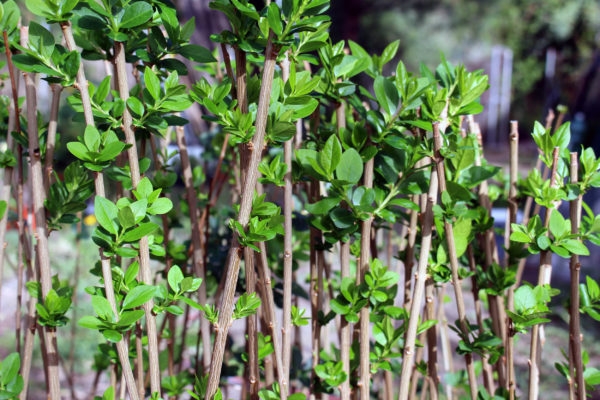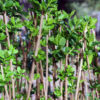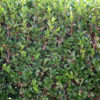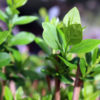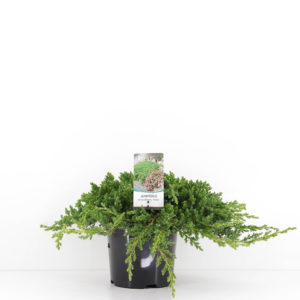Description
Summary
Ligustrum ovalifolium (California privet) comes from Japan and is a plant that is primarily used for hedging. The shrub reaches a height of up to 5 metres and is completely resistant to drastic pruning. To create dense hedges, it is recommended to prune the shrub vigorously in autumn or spring before new shoots sprout. The more the plant is pruned, the denser it becomes.
Ligustrum ovalifolium tolerates temperatures from -20 to 40 degrees Celsius without any problems and even weeks of drought cannot harm the robust plant. At temperatures below 10 degrees Celsius, the shrub loses its leaves. To create dense hedges, it is recommended to plant 2 – 3 plants per metre.
Due to its robustness and pruning tolerance, the oval-leaved privet is also very suitable for creating a bonsai.
Information
Ligustrum ovalifolium, commonly known as the Japanese privet or California privet, is an evergreen shrub that belongs to the Oleaceae family. It is native to Japan and Korea but has been widely cultivated in many parts of the world due to its ornamental qualities and ability to form dense hedges.
Appearance
Japanese privet is a medium-sized shrub that typically grows between 6 to 12 feet (1.8 to 3.7 meters) tall, but in some favorable conditions, it can reach up to 15 feet (4.6 meters). The plant has an upright, dense, and bushy habit with arching branches. The leaves are opposite, glossy, oval to elliptical in shape, and measure around 1 to 3 inches (2.5 to 7.6 cm) long. The foliage is semi-evergreen in colder climates, retaining its leaves during mild winters, but it may lose some leaves during colder temperatures.
Flowers
In late spring to early summer, Japanese privet produces fragrant, small, tubular, creamy-white flowers in clusters at the ends of branches. The flowers are attractive to bees and other pollinators.
Fruit: After flowering, the shrub produces small, round, black berries that are about 1/4 inch (0.6 cm) in diameter. These berries can persist on the plant through the fall and into the winter, providing a food source for birds.
Preferred Growing Conditions
Sunlight: Japanese privet thrives in full sun to partial shade. It will tolerate some shade, but flowering and fruiting may be reduced.
Soil: It prefers well-draining, fertile soil but can tolerate a variety of soil types, including clay and sandy soils.
Moisture: Once established, Japanese privet is relatively drought-tolerant but benefits from regular watering during dry periods, especially when it is young.
Temperature: It can tolerate moderate cold but may suffer damage in severe winters, particularly in colder regions.
Invasive Potential: One significant concern with Ligustrum ovalifolium is its potential to become invasive in some regions, particularly in parts of North America. The plant can spread rapidly, displacing native vegetation and disrupting ecosystems. As a result, in some areas, it is considered an invasive species, and its cultivation may be restricted or discouraged.
Uses
Hedge Planting: One of the most common uses of Japanese privet is as a hedge or screen plant. Its dense growth habit and ability to tolerate pruning make it popular for creating privacy barriers.
Ornamental Plant: The shrub’s glossy foliage and attractive flowers make it a popular choice for ornamental planting in gardens and landscapes.
Wildlife Attraction: The flowers attract pollinators, and the berries are a food source for birds, making it valuable for wildlife gardens.
Maintenance
Japanese privet is relatively low-maintenance. It responds well to pruning, allowing it to be shaped into various forms and sizes. Regular pruning can help control its growth and prevent it from becoming invasive. Despite its popularity as a landscaping plant, it’s essential to consider its potential invasiveness and environmental impact before choosing Ligustrum ovalifolium for your garden. Always check with local authorities or horticulture experts to ensure it is a suitable and responsible choice for your area.
Scientific name: Ligustrum Ovalifolium
Common name: California privet, garden privet, Korean privet, oval-leaved privet
Origin: Japan
Height of growth: Up to 5 metres
Sensitive to cold: No
Sensitive to heat: No
Sensitive to wind: No
Suitable as bonsai: Yes
Plant height: approx. 50 cm
Delivery form: Balled plants

